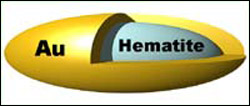
Nanoparticle’s shape could improve chemical sensing, biological imaging
Who better to invent “nanorice” than researchers at Rice University? But marketing and whimsy weren’t what motivated the team of engineers, physicists and chemists from Rice’s Laboratory for Nanophotonics (LANP) to make rice-shaped particles of gold and iron oxide.
“On the nanoscale, the shape of a particle plays a critical role in how it interacts with light,” said LANP Director Naomi H
Embryonic development is already disturbed at concentrations 10 times lower than the norm for human consumption.
Dioxin-like contaminants such as PCB’s are probably playing a key role in the extinction of the eel. Embronyic development in this species is halted at dioxin concentrations 10 times below the levels for human consumption. This discovery was made by a team of biologists, led by Guido van den Thillart, who are conducting research in Leiden into the sexual maturity and
The behavior of a massive ice sheet that existed in northern Europe at the end of the last Ice Age has been outlined for the first time, and researchers believe it may provide a sneak preview of how major ice sheets in Greenland and Antarctica will act in the face of global warming.
The study, which will be published Friday in the journal Science by researchers from Oregon State University, shows that ice sheets can react quite differently depending on the climatic conditions
Effects could extend from base of food chain to native hunters
Physical changes–including rising air and seawater temperatures and decreasing seasonal ice cover–appear to be the cause of a series of biological changes in the northern Bering Sea ecosystem that could have long-range and irreversible effects on the animals that live there and on the people who depend on them for their livelihoods.
In a paper published March 10 in the journal Science, a team of U.S. and
A major conservation effort, led by Dr Brendan Godley of the University of Exeter, has just got underway to help protect endangered leatherback turtles which nest in Gabon, West Africa. The region is thought to be the animals’ last global stronghold, as pacific populations dwindle precariously.
It’s hoped the project, to tag and track the animals, will uncover their migratory secrets and provide the basis for efforts to safeguard them. After fitting them with satelli
The Volvo Ocean Race yachts have safely rounded Cape Horn on the fourth leg of their round-the-world adventure thanks to the help of radar satellites steering them away from dangerous icebergs.
While all the legs of the race have their unique dangers, Volvo Ocean Race Meteorologist Chris Bedford said leg four is arguably the most dangerous. “The boats have to face 50-knot storms, massive seas and possible ice, and if something happens on the leg, help is many hours and, more li